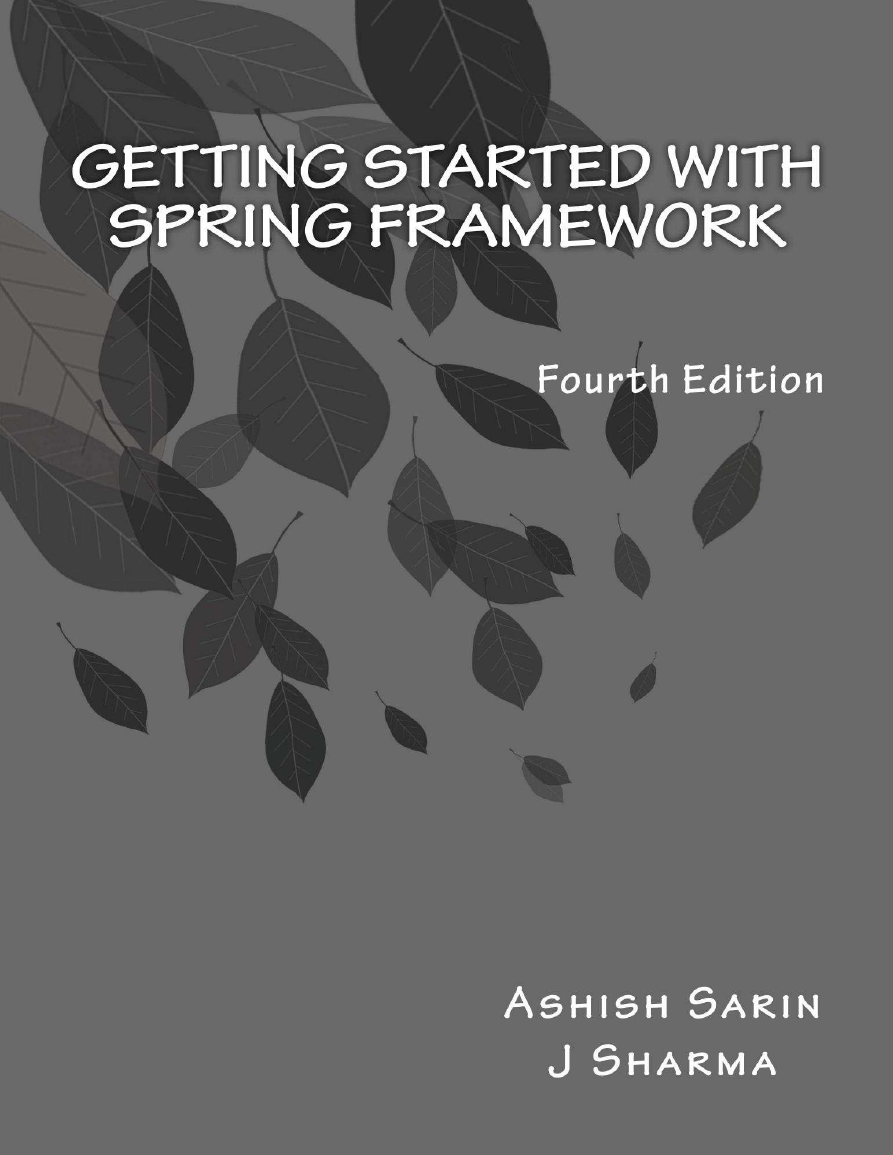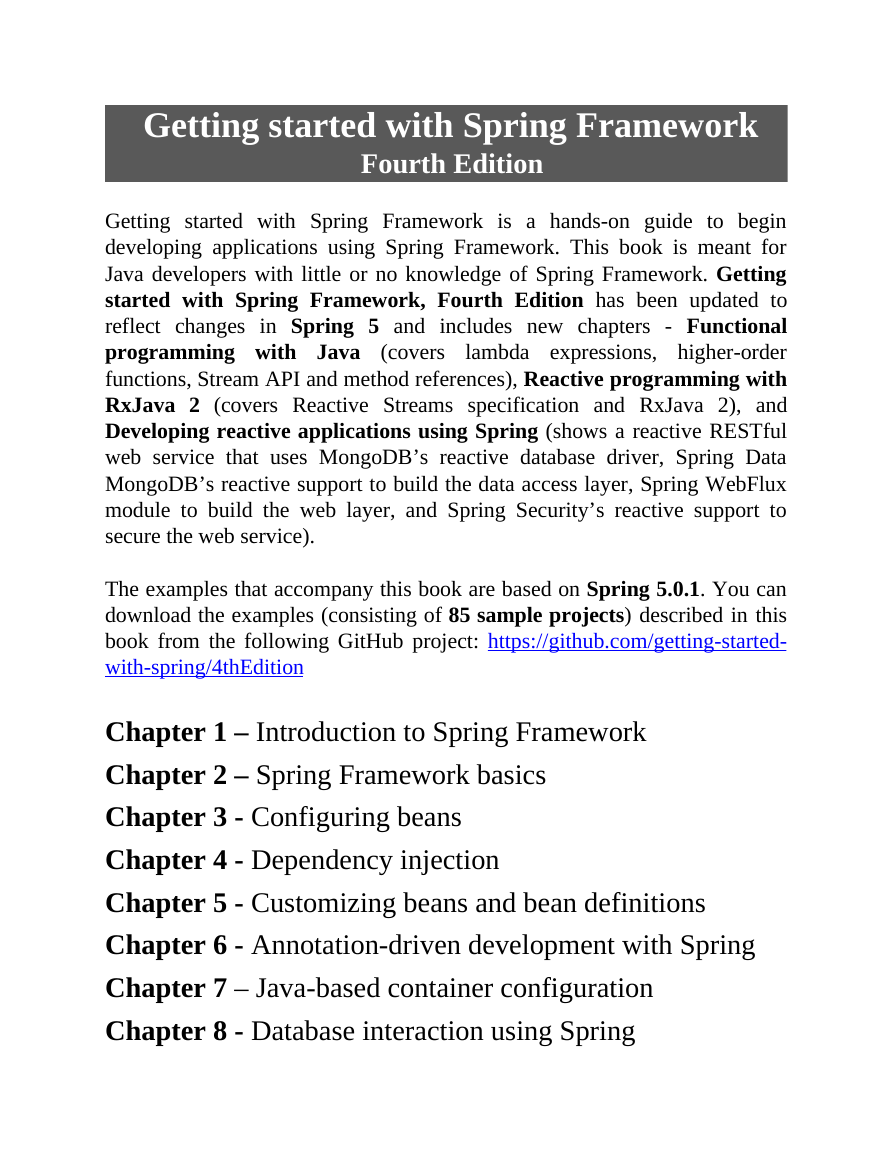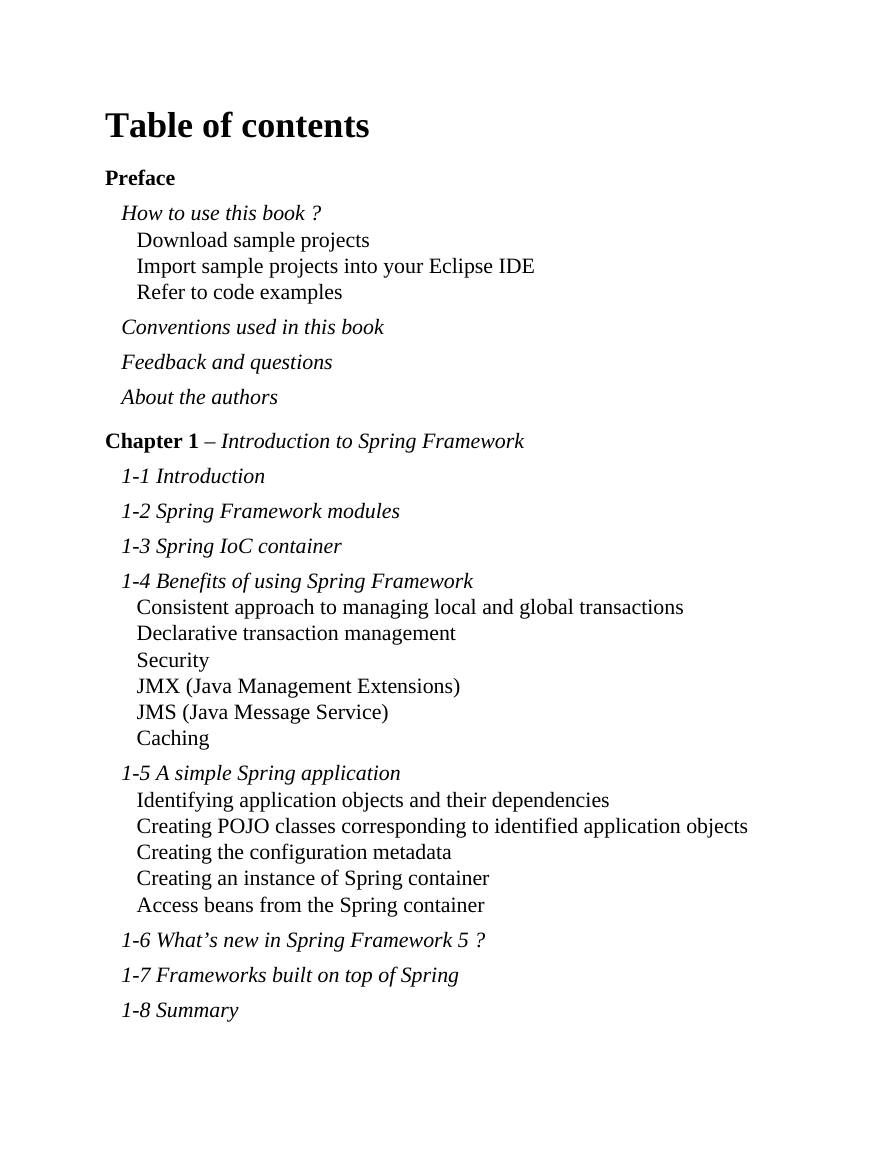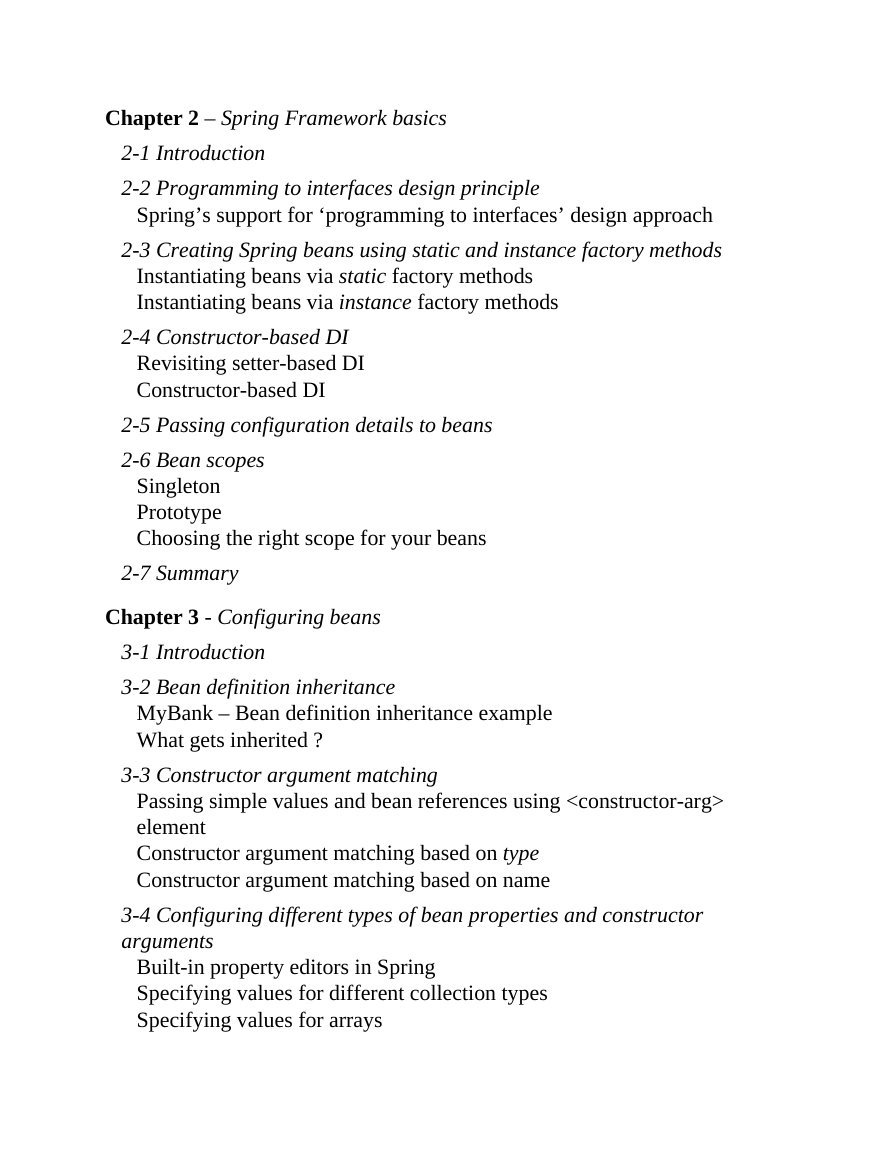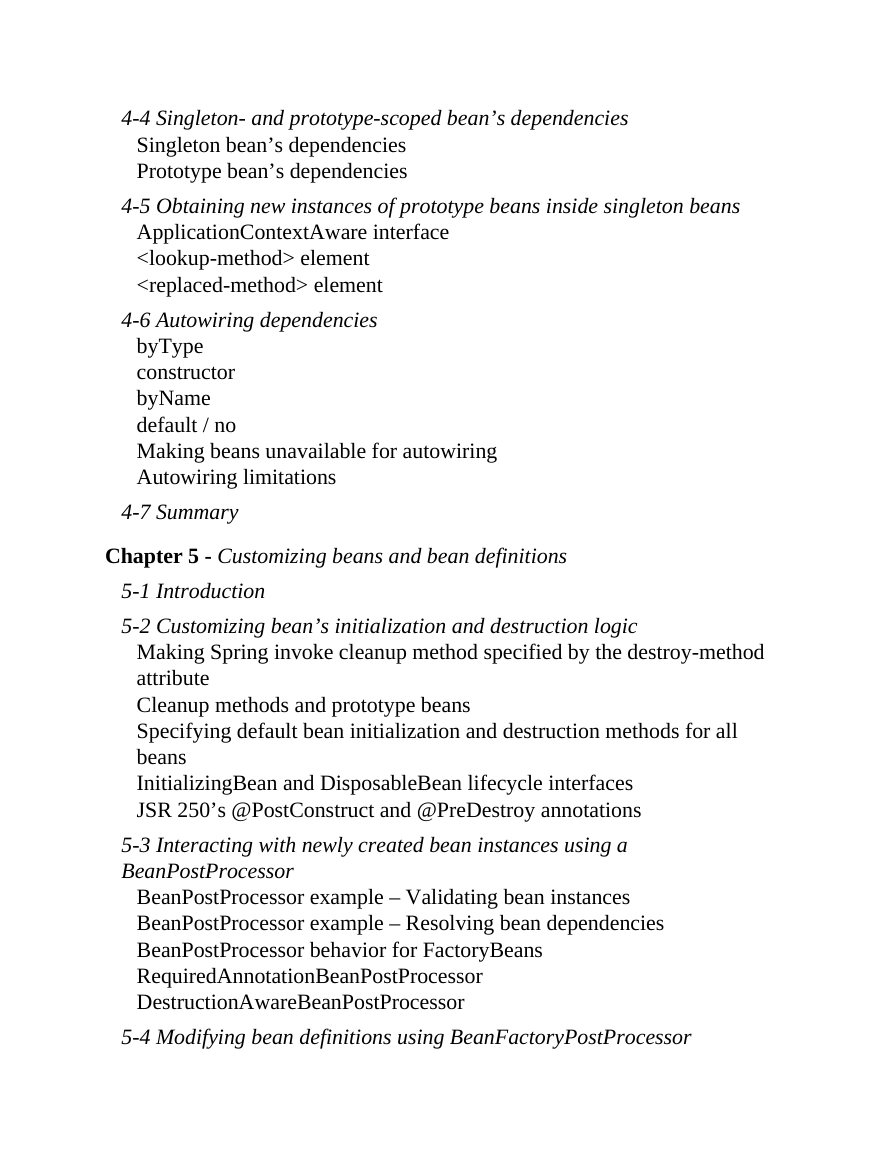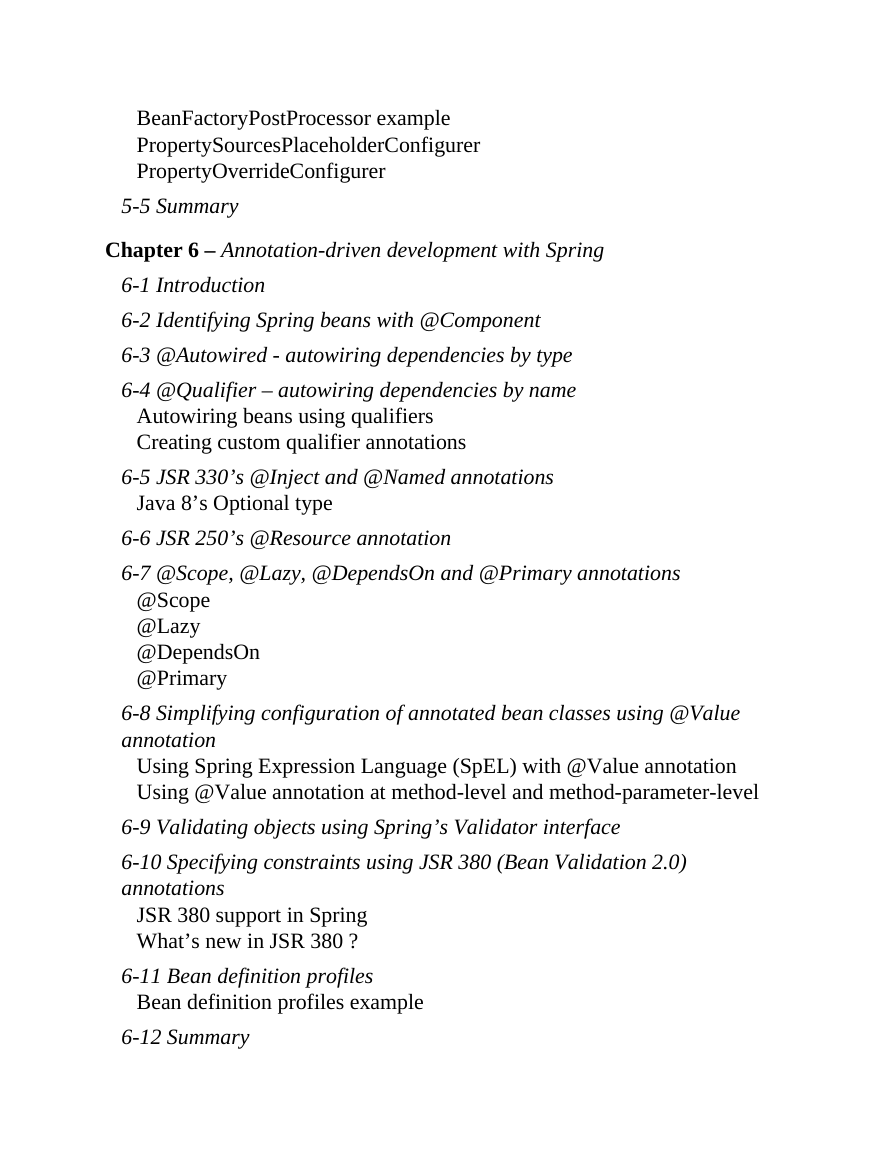Getting started with Spring Framework
Fourth Edition
Ashish Sarin, J Sharma
Table of contents
Preface
How to use this book ?
Conventions used in this book
Feedback and questions
About the authors
1-1 Introduction
1-2 Spring Framework modules
Core container
AOP and instrumentation
Messaging
Data Access/Integration
Web
Test
1-3 Spring IoC container
1-4 Benefits of using Spring Framework
1-5 A simple Spring application
1-6 What’s new in Spring Framework 5 ?
1-7 Frameworks built on top of Spring
Spring Security
Spring Data
Spring Batch
Spring Integration
Spring Social
1-8 Summary
2-1 Introduction
2-2 Programming to interfaces design principle
2-3 Creating Spring beans using static and instance factory methods
2-4 Constructor-based DI
2-5 Passing configuration details to beans
2-6 Bean scopes
2-7 Summary
3-1 Introduction
3-2 Bean definition inheritance
3-3 Constructor argument matching
3-4 Configuring different types of bean properties and constructor arguments
CustomBooleanEditor
CustomNumberEditor
CharacterEditor
CustomDateEditor
PropertiesEditor
java.util.ArrayList
java.util.LinkedHashSet
java.util.LinkedHashMap
3-5 Built-in property editors
3-6 Registering property editors with the Spring container
3-7 Concise bean definitions with p and c namespaces
3-8 Spring’s util schema
3-9 FactoryBean interface
DatabaseEventSender
MessagingEventSender
WebServiceEventSender
3-10 Modularizing bean configuration
3-11 Summary
4-1 Introduction
4-2 Inner beans
4-3 Controlling the bean initialization order with depends-on attribute
4-4 Singleton- and prototype-scoped bean’s dependencies
4-5 Obtaining new instances of prototype beans inside singleton beans
4-6 Autowiring dependencies
4-7 Summary
5-1 Introduction
5-2 Customizing bean’s initialization and destruction logic
5-3 Interacting with newly created bean instances using a BeanPostProcessor
5-4 Modifying bean definitions using BeanFactoryPostProcessor
5-5 Summary
6-1 Introduction
6-2 Identifying Spring beans with @Component
annotation
assignable
aspectj
regex
custom
6-3 @Autowired - autowiring dependencies by type
6-4 @Qualifier – autowiring dependencies by name
6-5 JSR 330’s @Inject and @Named annotations
6-6 JSR 250’s @Resource annotation
6-7 @Scope, @Lazy, @DependsOn and @Primary annotations
@Scope
@Lazy
@DependsOn
@Primary
6-8 Simplifying configuration of annotated bean classes using @Value annotation
6-9 Validating objects using Spring’s Validator interface
6-10 Specifying constraints using JSR 380 (Bean Validation 2.0) annotations
@NotNull
@Min
@Max
@NotBlank
@Size
6-11 Bean definition profiles
6-12 Summary
7-1 Introduction
7-2 Configuring beans using @Configuration and @Bean annotations
autowire
initMethod
destroyMethod
7-3 Injecting bean dependencies
7-4 Configuring the Spring container
7-5 Lifecycle callbacks
7-6 Importing Java-based configurations
7-7 Additional topics
7-8 Summary
8-1 Introduction
8-2 MyBank application’s requirements
8-3 Developing the MyBank application using Spring’s JDBC module
8-4 Developing the MyBank application using Hibernate
8-5 Transaction management using Spring
8-6 Developing the MyBank application using Java-based configuration
8-7 Summary
9-1 Introduction
9-2 Core concepts and interfaces
9-3 Spring Data JPA
9-4 Creating queries using Querydsl
9-5 Query by Example (QBE)
9-6 Spring Data MongoDB
9-7 Summary
10-1 Introduction
10-2 MyBank application’s requirements
10-3 Sending JMS messages
10-4 Receiving JMS messages
10-5 Sending emails
10-6 Task scheduling and asynchronous execution
10-7 Caching
10-8 Running the MyBank application
10-9 Summary
11-1 Introduction
11-2 A simple AOP example
11-3 Spring AOP framework
11-4 Pointcut expressions
access-modifier-pattern
return-type-pattern
declaring-type-pattern
method-name-pattern
method-param-pattern
throws-pattern
11-5 Advice types
11-6 Spring AOP - XML schema-style
11-7 Summary
12-1 Introduction
12-2 Directory structure of sample web projects
12-3 Understanding the ‘Hello World’ web application
HelloWorldController.java
helloworld.jsp
myapp-config.xml
web.xml
12-4 DispatcherServlet – the front controller
Bean scope
request
session
application
websocket
12-5 Developing controllers using @Controller and @RequestMapping annotations
12-6 MyBank web application’s requirements
12-7 Spring Web MVC annotations - @RequestMapping and @RequestParam
12-8 Validation
12-9 Handling exceptions using @ExceptionHandler annotation
12-10 Loading root web application context XML file(s)
12-11 Summary
13-1 Introduction
13-2 Adding and retrieving model attributes using @ModelAttribute annotation
13-3 Caching model attributes using @SessionAttributes annotation
13-4 Data binding support in Spring
WebBindingInitializer
13-5 Validation support in Spring
@NotNull
@Min
@Max
@Size
@Email
13-6 Spring’s form tag library
